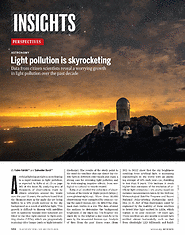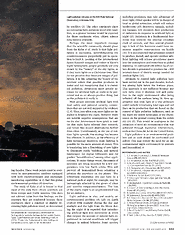Light pollution needs to be treated as such. St. Johns County already limits lights near beaches to protect endangered turtles, pursuant to settlement of a federal court Endangered Species Act case.
From AAAS's SCIENCE Magazine:
Light pollution is skyrocketingIN SECTION PERSPECTIVE | ASTRONOMY

Artificial lighting at night is contributing to a rapid increase in light pollution, as reported by Kyba et al. (1) on page 265 of this issue. By analyzing tens of thousands of observations made by citizen scientists around the world over the past 12 years, the authors found that the dimmest stars in the night sky are being hidden by a 10% yearly increase in the sky background as a result of artificial light. This growth is difficult to discern with satellites now in operation because their detectors are blind to the blue light emitted by light-emitting diodes (LEDs), which are progressively replacing older lamps (such as high-intensity discharge). The results of the study point to the need for satellites that can detect the visible light in different color bands and make a strong case for reversing light pollution and its wide-ranging negative effects, from ecological to cultural to health-related.
Kyba et al. studied the collection of observations of the Globe at Night project (https://www.globeatnight.org). More than 50,000 observations were submitted by citizens—using the naked human eye—to detect the dimmest stars visible in a site. The data allowed the authors to determine the background brightness of the night sky. The brighter the night sky is, the brighter a star must be to be seen by the unassisted human eye. Analysis of data from the past dozen years (from 2011 to 2022) show that the sky brightness resulting from artificial light is increasing exponentially in the world with an alarming average of 10% each year—i.e., doubling in less than 8 years. This increase is much higher than estimates of the evolution of artificial light emissions (∼2% yearly) based on radiance measurements taken by the Defense Meteorological Satellite Program and Suomi National Polar-orbiting Partnership satellites (2, 3). Part of this discrepancy could be explained by the inability of these satellites to detect blue light emitted by LEDs, which started to be used outdoors ∼10 years ago. These satellites are also unable to detect light emitted almost horizontally, such as that from ultrabright LED billboards and building façades. These weak points must be overcome by next-generation satellites equipped with both multiwavelength and multiangle monitoring capabilities (4, 5) that this global environmental problem (6) deserves.
The study of Kyba et al. is biased in that most of the data from citizen scientists are from Europe and North America. This does not subtract value from the findings; on the contrary, they are reinforced because these continents show a constant or slightly decreasing light pollution trend, as determined by satellites (2). The other continents show an increasing light pollution trend with satellites, so a greater increase would be expected for those continents when citizen science data become available.
Perhaps the most important message that the scientific community should glean from the Kyba et al. study is that light pollution is increasing, notwithstanding the counter measures purportedly put in operation to limit it. Looking at the International Space Station’s images and videos of Earth’s night hemisphere, people generally are only struck by the “beauty” of the city lights, as if they were lights on a Christmas tree. They do not perceive that these are images of pollution. It is like admiring the beauty of the rainbow colors that gasoline produces in water and not recognizing that it is chemical pollution. Awareness must greatly increase for artificial light at night to be perceived not as an always-positive thing, but as the pollutant it really is.
Most people associate artificial light with road safety and personal security, connections that are not well supported by evidence (7, 8). Thus, year after year, more lights are installed to brighten the night. However, there are notable negative consequences that are on the rise. Astronomers were quick to realize that night lights affected their research, and hence they moved observatories farther from cities. Unfortunately, as the use of outdoor lights spreads, this strategy has become less effective. In addition, as the efficiency of light technology improves, more lighting is possible for the same amount of money. This is translating into a flourishing of new lights to illuminate roads, buildings, and natural landscapes; for digital billboards; and for garden “beautification,” among other applications. To make things worse, thousands of satellites are being launched by a few corporations into low Earth orbits. This will prevent all humankind from admiring a pristine sky anywhere on the planet. The wilderness experience one can have in a national park at night, for example, may be increasingly affected by the glows of cities and satellite megaconstellations. The loss of the starry night is an unprecedented loss for all cultures.
Light pollution is also, and mainly, an environmental problem (9). Life on Earth evolved with sunlight during the day and starlight and the light from the Moon during the night. It is expected that introducing artificial light into ecosystems at levels that surpass the amount of natural light experienced in natural conditions will trigger changes in animal behavior. Some species, including predators, may take advantage of more light. Other species will be in danger of local or global extinction, which will reduce biodiversity (10). Moreover, animals, including humans, will diminish their production of melatonin in response to artificial light at night (11). Melatonin is a fundamental hormone that controls the internal circadian clock of animals, and thus animal physiology. A lack of this hormone could have numerous negative consequences on health (12). It is also expected that processes needed to produce, install, and operate outdoor artificial lighting will release greenhouse gases into the atmosphere and contribute to global warming. An estimated 200 billion kg of carbon dioxide is generated to produce the ∼400 terawatt-hours of electric energy needed for outdoor lights (13).
Attempts to control light pollution have been carried out in the past decades, including aiming light below the horizon plane. This approach is not sufficient because any new light, even if shielded, will add pollution to the night environment after being reflected off the surfaces being lit. New approaches that treat light as a true pollutant could include introducing total caps and red lines on its production that are based on the control of light pollution indicators, such as the night sky zenith luminance or the illuminance on the ground coming from the entire sky (14, 15). This would be analogous to the reduction of most air contaminants that was achieved through legislative interventions, such as the Clean Air Act in the United States.
Light pollution is an environmental problem and as such should be confronted and solved. This may restore the need for an uncontaminated night environment by animals and humankind.
REFERENCES AND NOTES
10.1126/science.adf4952


No comments:
Post a Comment